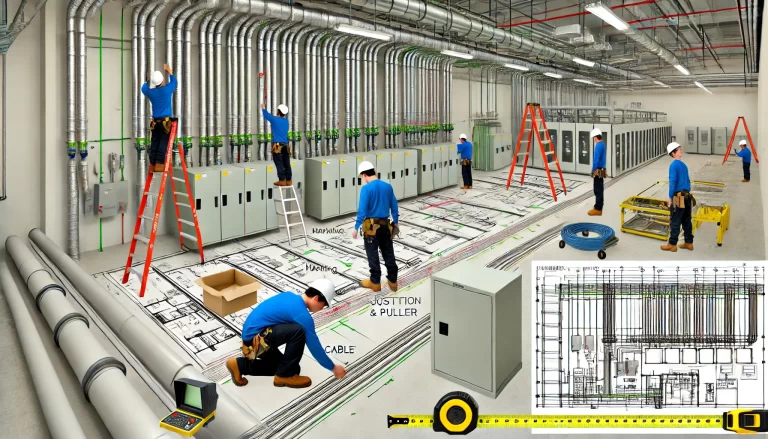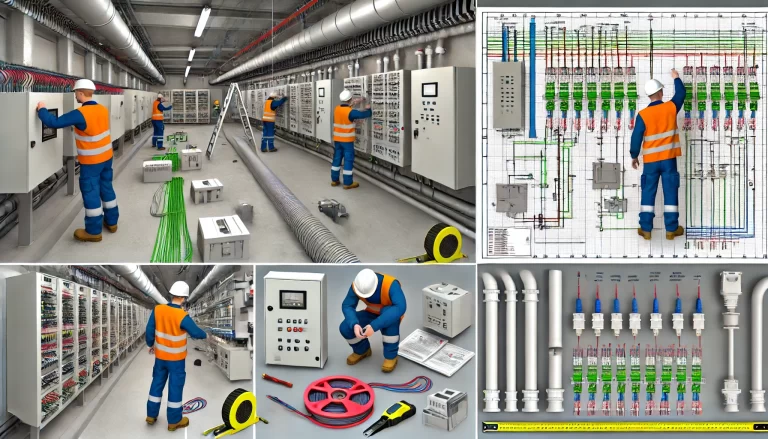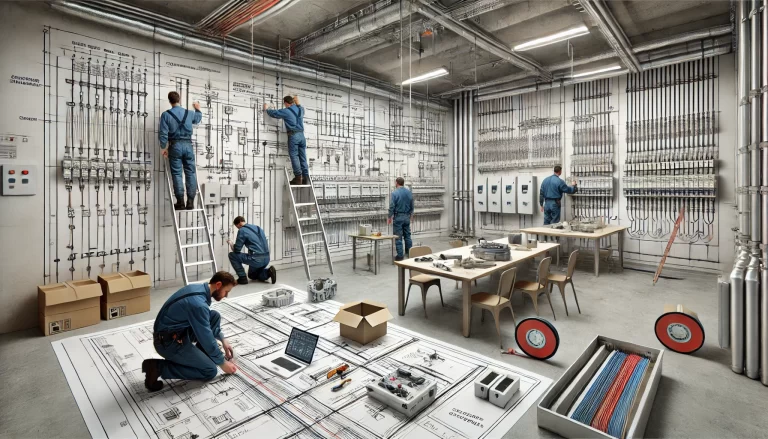Laying conduit and cabling in instrumentation and control systems requires careful planning and execution to ensure both efficiency and long-term reliability. These systems are often intricate and sensitive to electrical interference, making proper cable management essential. In this article, we will explore key steps and best practices for efficiently laying conduits and cables in industrial environments.
1. Comprehensive Planning and Design
A well-thought-out design is crucial for efficient installation. Inadequate planning can lead to delays, rework, and even system malfunctions. Here are some essential steps:
Detailed Route Planning: Start with a comprehensive layout of the facility, marking the locations of all instruments, control panels, junction boxes, and cable trays. Plan the shortest and most direct routes for conduits to minimize material usage and avoid interference from equipment, walls, or structural elements. Routing should also account for future expansion or maintenance accessibility.
Space Management: In tight spaces, ensure that conduits don’t overcrowd each other or other systems (such as HVAC ducts or plumbing). Using raceways or cable trays in congested areas can help organize the conduit while maintaining easy access for future modifications.
Safety and Compliance: Plan with local codes and regulations in mind. Ensure the routes follow safety standards, such as maintaining minimum distances from combustible materials or areas exposed to potential hazards like chemicals or high temperatures.

2. Selecting Appropriate Materials and Tools
The choice of materials directly impacts the efficiency and durability of the installation. Using the right tools ensures faster, more accurate work.
Conduit Types: Based on environmental factors such as moisture, temperature, and potential chemical exposure, select the appropriate conduit material (e.g., PVC, galvanized steel, or flexible metallic conduits). For example, PVC conduits may be suitable for wet or corrosive environments, while steel conduits offer superior durability in industrial settings.
Conduit Fittings: Use appropriate fittings to reduce strain on cables and ensure smooth bends. Long-radius bends minimize the risk of cable damage during pulling, while expansion couplings allow for temperature-induced movement, especially in large installations.
Tools: Equip the team with proper tools, such as conduit benders, hydraulic cutters, and pull strings. Modern tools such as automatic cable pullers can significantly reduce manual effort and save time, especially for long cable runs or heavy-duty installations.
3. Modular and Pre-Fabrication Approaches
Using a modular approach can drastically improve installation speed. Pre-fabrication involves building sections of the system off-site or in advance, which can then be quickly assembled on-site.
Pre-Fabricated Conduits: Pre-cut and bend conduit sections in a controlled environment before bringing them to the field. This minimizes on-site cutting, bending, and adjustments, leading to a more streamlined installation. Modular sections of conduits can also be labeled, simplifying the assembly process.
Segmented Installation: Divide the installation process into stages or segments based on geographic zones or system functionality. This modular approach allows different teams to work simultaneously in different areas, optimizing overall workflow and reducing downtime.

4. Optimized Team Collaboration and Workflows
Effective teamwork and clear communication are essential for smooth operations. Here’s how to optimize team performance:
Task Specialization: Assign specialized tasks to team members based on their skills. For example, one team can focus on pulling cables while another handles conduit bending and installation. By dividing tasks according to expertise, you can avoid bottlenecks and speed up the entire process.
Simultaneous Operations: If safety and space allow, multiple teams can work in different areas simultaneously. For instance, one team can be installing conduit while another follows behind pulling cables or mounting equipment.
Pre-Installation Briefings: Hold daily or pre-shift meetings to clarify tasks, resolve potential conflicts, and ensure that all workers understand the day’s goals. This reduces misunderstandings and helps align the team’s efforts toward a common objective.
5. Utilizing Modern Tools and Technologies
Advancements in tools and technology have revolutionized the process of conduit and cable laying, making it faster, more precise, and less labor-intensive.
Laser Measurement Tools: Laser-guided tools are invaluable for ensuring precise placement of conduits, reducing measurement errors, and speeding up the installation process. These tools can mark drilling points and conduit pathways quickly and accurately.
Automated Cable Pullers: For long cable runs or heavy-duty industrial environments, automated or motorized cable pullers save significant time and effort. These machines can pull long sections of cable through conduits with consistent force, reducing the risk of damage from pulling by hand.
Cable Marking Systems: Using color-coded cables or digital labeling systems can streamline installation and future maintenance. These systems allow for quicker identification of cable types, destinations, or functions, reducing confusion during troubleshooting or expansion.

5. Utilizing Modern Tools and Technologies
Advancements in tools and technology have revolutionized the process of conduit and cable laying, making it faster, more precise, and less labor-intensive.
Laser Measurement Tools: Laser-guided tools are invaluable for ensuring precise placement of conduits, reducing measurement errors, and speeding up the installation process. These tools can mark drilling points and conduit pathways quickly and accurately.
Automated Cable Pullers: For long cable runs or heavy-duty industrial environments, automated or motorized cable pullers save significant time and effort. These machines can pull long sections of cable through conduits with consistent force, reducing the risk of damage from pulling by hand.
Cable Marking Systems: Using color-coded cables or digital labeling systems can streamline installation and future maintenance. These systems allow for quicker identification of cable types, destinations, or functions, reducing confusion during troubleshooting or expansion.

Conclusion
Efficiently laying conduits and cables in an industrial or instrumentation environment requires meticulous planning, the right materials, and modern tools, combined with effective team collaboration. By following these best practices, you can optimize the installation process, reduce project timelines, and ensure the long-term reliability of the system. Ensuring that quality and safety are maintained throughout the process is crucial for minimizing future issues and ensuring that the system performs at its best for years to come.
